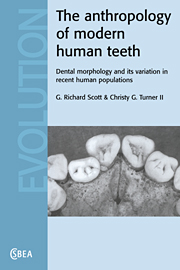 The Anthropology of Modern Human Teeth
The Anthropology of Modern Human Teeth Book contents
- Frontmatter
- Dedication
- Contents
- Acknowledgments
- Prologue
- 1 Dental anthropology and morphology
- 2 Description and classification of permanent crown and root traits
- 3 Biological considerations: ontogeny, asymmetry, sex dimorphism, and intertrait association
- 4 Genetics of morphological trait expression
- 5 Geographic variation in tooth crown and root morphology
- 6 Establishing method and theory for using tooth morphology in reconstructions of late Pleistocene and Holocene human population history
- 7 Tooth morphology and population history
- Epilogue
- Appendixes
- References
- Index
Prologue
Published online by Cambridge University Press: 05 September 2015
- Frontmatter
- Dedication
- Contents
- Acknowledgments
- Prologue
- 1 Dental anthropology and morphology
- 2 Description and classification of permanent crown and root traits
- 3 Biological considerations: ontogeny, asymmetry, sex dimorphism, and intertrait association
- 4 Genetics of morphological trait expression
- 5 Geographic variation in tooth crown and root morphology
- 6 Establishing method and theory for using tooth morphology in reconstructions of late Pleistocene and Holocene human population history
- 7 Tooth morphology and population history
- Epilogue
- Appendixes
- References
- Index
Summary
This book is about teeth in general and tooth morphology in particular. Excluding rare cases of anodontia, where individuals never develop teeth, all humans in all places at all times had, have, or will have teeth. People use and see their teeth every day, but ordinarily take them for granted except when they are a source of pain or discomfort. Most pay even less attention to the morphology of teeth. By simply feeling the chewing surfaces of the individual teeth at the back of the mouth, one can discern elevations or bumps that are separated from one another by depressions or concavities. These teeth in the back of the mouth are molars, the bumps are cusps, and the depressions are fissures, fossae, grooves, or sulci, depending on their form and depth. More difficult to palpate are the many ridges that may be present on the cusps or along the margins of a tooth. It is elements such as cusps, ridges, fissures, and even the number of roots each tooth possesses that occupy the attention of the dental morphologist.
What are human perceptions (or misconceptions) about those hard white objects in our mouths that we (should) brush and floss everyday? Individual knowledge of teeth is highly variable within populations and between different cultures. In Folklore of the Teeth,Leo Kanner (1928) reviews a broad range of subjects, including the diversity of views on toothaches and dental hygiene and varied practices in artificial dental deformation. In his first chapter, on tooth number, shape, and eruption, Kanner (1928:3) discusses how many early scholars were misinformed on something as basic as the number of teeth an individual possessed: ‘We not infrequently meet with individuals of sometimes more than fair intelligence who become embarrassed when questioned as to how many teeth they have.’
As dental anthropologists who have observed at least one million teeth, we sometimes take for granted what the average individual knows about their own teeth. Kanner's observations on dental misconceptions in earlier and recent times stimulated a survey of 80 university students and their friends and families who had to respond to four questions: (1) how many deciduous (baby) teeth do humans have? (2) how many permanent teeth do humans have? (3) how many types of teeth do humans possess? and (4) do teeth play a role in attracting members of the opposite sex?
- Type
- Chapter
- Information
- The Anthropology of Modern Human TeethDental Morphology and its Variation in Recent Human Populations, pp. xiii - xxivPublisher: Cambridge University PressPrint publication year: 1997


